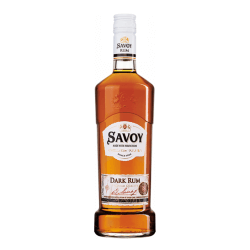
Savoy Dark Rum | 0,7 l
13,90 Euro1 l costs 19,86 Euro
Savoy Dark Rum | 1 l
16,90 Euro1 l costs 16,90 Euro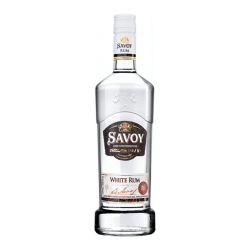
Savoy White Rum | 0,7 l
14,90 Euro1 l costs 21,29 Euro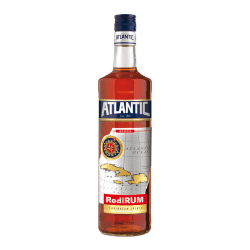
Sinhron Atlantic Red Rum | 0,7 l
15,90 Euro1 l costs 22,71 Euro
Sinhron Atlantic Red Rum | 1 l
Sold out20,90 Euro1 l costs 20,90 Euro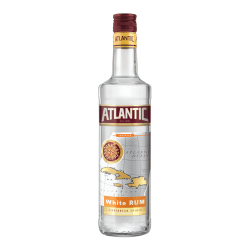
Sinhron Atlantic White Rum | 0,7 l
Sold out15,90 Euro1 l costs 22,71 Euro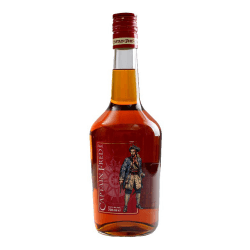
Peshtera Captain Fred Dark | 0,7 l
Sold out15,90 Euro1 l costs 22,71 Euro
Peshtera Captain Fred Dark PET | 0,2 l
Sold out3,99 Euro100 ml cost 2,00 Euro
Savoy White Rum | 0,7 l
14,90 Euro1 l costs 21,29 EuroRum - Caribbean drinking pleasure in Bulgarian
Rum is a versatile drink, which is accompanied by a long and adventurous history. Due to its intense colouring, the spirit has been known as liquid gold since its beginnings. The basis for its production is sugar cane, in its various varieties and special flavours. Nowadays, the various types of rum and the corresponding mixed drinks stand for an animating holiday feeling in the Caribbean. So it is not surprising that sugarcane liquor has been enjoying a steadily growing attention all over the world for some years now. The multifaceted nature of rum is characterised by the raw materials used and the production processes employed. In this way, exceptional derivatives have been established in many countries, which are characterised by very special aroma and taste characteristics. In the production of rum, both the quality of the ingredients and the distillation and maturing time in oak barrels determine the aromatic quality of the final flavour.
Rum - eventful origin and exciting history
The origin of rum is closely linked to the discovery of America and the resulting trade between the continents. Already in the early 17th century the spirit was produced in the sugar cane plantations of the Caribbean islands and in South America. During this epoch there was a permanently increasing demand for sugar in Europe, so that the colonial masters cultivated abundant sugar cane on their plantations overseas. Due to the overproduction of cane sugar, slaves discovered that the waste product molasses could be processed into an alcoholic beverage. Soon after this discovery, molasses was used for distillation to produce high-proof alcohol. Sugar cane brandy gained its first and very dubious reputation as the favourite drink of sailors and pirates. Hence the name rum, which is derived from the dialectal word rumbullion, meaning riot or tumult. But soon all classes of society discovered the manifold flavours of the spirit, which, thanks to the improvement of the production processes, could convince with exquisite qualities. However, over the centuries, sugar cane has become less and less important as an export product. The sweet raw material was replaced by the Europe-wide cultivation of sugar beet. However, rum is gaining more and more popularity and is becoming one of the most popular spirits all over the world, so that sugar cane continues to be cultivated with success.
Rum - not only sugar cane: The most important ingredients
Sugar cane belongs to the sweet grass family and is dependent on tropically warm site conditions, which is why the plant can be cultivated excellently in the Caribbean. Thanks to the good climate, harvesting takes place up to twice a year. The raw material is then pressed to produce fresh sugar cane juice, sugar cane syrup and molasses, the latter being a vegetable residue from sugar production. All these by-products of sugar extraction are required for rum production. If the rum is made predominantly from molasses, it often develops a very intense vanilla aroma. These types of rum are also rounder and more pleasing than those made from fresh sugar cane juice. Sugar cane syrup is a highly concentrated starting product, so that the resulting rum is much more aromatic. In order to transform the basic mixture containing sugar into an alcoholic drink, water and yeast are added. The solution then ferments and the sugar it contains is converted into alcohol. As soon as all the sugar has been converted, the process comes to an end, with the alcohol content reaching about 16%. During this process, the yeast cannot produce a higher alcohol content, as the ingredient would otherwise die off. The next step to achieve the higher alcohol content is distillation.
Rum - traditional production methods
As soon as the alcoholic fermentation of the mash is completed, distillation begins. In the Spanish regions, rum is mostly distilled in columns using the column still method. The former colonies of the English and French, on the other hand, mainly rely on distilling in boilers, the Pot Still process. Afterwards the distillate has an extremely high alcohol content of 65 to 75% vol. Therefore it has to be brought to the desired drinking strength with distilled water. The minimum alcohol content for rum is 37.5 percent by volume. There are also varieties with an alcohol content between 40 and 54 percent by volume. In this respect, the liquid containing alcohol is subject to the strict guidelines of the EU. As a result, the various types of rum may not be sweetened or flavoured afterwards. No additional alcohol may be added either. Furthermore, blending is often used in the production of rum. This term describes a mixture of different types of rum or distillates. The brandies can have the same origin or come from different distilleries. With this blending, specific types of rum can be produced, which are only subject to slight variations in taste. In this way, the producers can consciously direct the aroma in the desired direction in order to meet the taste of a wider consumer group.
Traditionally passed down Rum
Just like other brandies, the distilled rum is first clear and transparent, so white rums are produced. The golden as well as brown to reddish tones are obtained either by storing the liquor in wooden barrels or by adding caramel syrup and sugar liqueur. This process not only gives the rum an attractive colour, but also gives it additional flavour aromas.
White Rum - Dark Rum - Red Rum
In view of the quantity produced, the reputation of white rum exceeds that of the other varieties. This rum is mainly distilled using the column distillation method and has a relatively high alcohol volume percentage. For this reason, the white rum is topped up with water immediately after distillation and addition. As a spirit, the alcoholic beverage is not yet mature at this stage. Therefore its taste is rather light and almost neutral. For this reason the white rum is mainly used for the popular cocktails Mojito and Daiquiri and is rarely drunk pure. Especially in the warm summer months, cool mixed drinks with rum such as Mai Tai or Planter's Punch provide a welcome refreshment.
Dark Rum gets its dark colour from the intensive maturing process in oak barrels. It is important to mature slowly and evenly to achieve a full and rich flavour with delicate shades of caramel. Many of these end products are assemblages of different types of rum to allow complex aromas to develop. A high quality dark rum is best drunk straight or with a little ice. But Dark Rum is also well suited for mixing cocktails. Whether rum is enjoyed pure or mixed always depends on your own taste preferences.
The Red Rum is also a dark-coloured type of rum, which has been flavoured with various spices. The possible ingredients include ginger, caramel, cloves, black pepper, vanilla and cinnamon. These spicy rums enjoy great popularity in cocktail bars, where bartenders use the spirits in tasty cocktails.
Rum - Aged in oak barrels
Especially good rums are stored in oak barrels, which results in remarkable differences in quality. This procedure affects both the visual and taste characteristics of the rum. The various aromas become finer and more versatile, and the taste is also much more intense. In most cases, these are barrels made from the wood of the white oak, which are previously charred on the inside. Depending on the manufacturer, this storage phase extends over different periods of time. During the course of storage, a little of the barrel's taste is transferred to the rum. This gives the spirit a slight sweetness, as the white oak has a high vanilla content. In addition, the rum takes on a brown hue with time. The longer a rum is allowed to store, the better the quality afterwards. A simple rum usually goes through a maturing period of three to six months. Special types of rum are stored considerably longer in the cellar vaults of the distilleries, some even for decades. Afterwards this high-quality rum is matured with a separate indication of the year. Aged rums develop very intense notes with ripe aromas of coffee, caramel, vanilla and dried fruit.
Rum - World famous rum cocktails and long drinks
Dark rums generally have a more intense aroma, are sweeter and have a more complex taste. Therefore these varieties are better suited for pure enjoyment. In contrast, lighter and younger rum varieties support the taste of the other ingredients in cocktails. However, a strong rum can also give mixed drinks an interesting base note. In the Caribbean, young distillates are enjoyed quite simply with a little sugar syrup and fresh limes as daiquiri. The dynamic spirit owes its worldwide popularity above all to the excellent cocktails that can be prepared with it. These include the mojito with lime and mint, which has become the current trend drink. In the exotic Mai Tai, darker is mixed with white rum, in combination with Cointreau, lime juice, almond syrup and a sprig of mint as decoration. The fruity Planter's Punch with orange and lemon juice is dominated by dark rum and a sweet note, thanks to grenadine and sugar syrup, garnished with a slice of lemon. A tried and tested classic among long drinks is the Cuba Libre, in which white rum is combined with cola and lime juice.
Bulgarian rum - convinces with versatile taste notes
In the meantime, rum no longer comes only from the Caribbean and South America. The popular spirit is also successfully produced in Bulgaria. When it comes to spirits, the Bulgarian people experiment with great pleasure and are also enthusiastic about the exotic sugarcane liquor. SAVOY Red Rum is produced according to an authentic recipe from the Caribbean, using only the best sugar cane. The production is made with a special technology to create a new and rich taste. Dark rum is produced in this way, creating natural aromas with subtle shades of caramel. Captain Fred Dark Rum provides a very special drinking experience, where pure grain alcohol is mixed with high-quality rum distillates. Due to the long storage phase in oak barrels, this Bulgarian rum is allowed to mature intensively and develops a delicate aroma. The taste notes include grapefruit, chocolate, vanilla and dry grass, which leave a taste explosion on the palate. Bulgarian rum is a real pleasure, both pure and in cocktails and long drinks. It creates a Caribbean lifestyle in your own home, in the cocktail bar and at any party.
